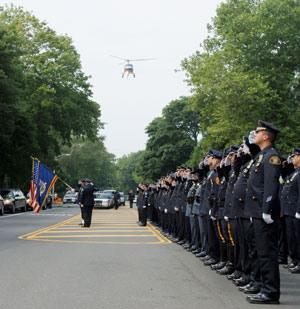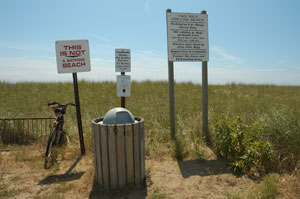Sagaponack Residents To Vote on Village Backers race to prepare for referendum
Sagaponack Residents To Vote on Village Backers race to prepare for referendum
Sagaponack residents have until Sept. 8 to vote on whether to become their own village.
The deadline to challenge the residents' petition for incorporation passed on Monday without comment.
Most of them were surprised to learn that no one had spoken against the petition. "Wow" was the operative word at Tuesday night's Sagaponack Citizens Advisory Committee meeting. "Be careful what you wish for," was the reaction of Peter Wadsworth, a committee member.
Lee Foster, whose family has a potato farm on Sagg Main Street, and who is the spokeswoman for the proposed village, said yesterday that she had just learned the news herself. "We have the green light," she said. "We'll move in the direction required to have a vote."
The Southampton town attorney's office and the town clerk will be very busy in the next few weeks organizing the election. Kathleen Murray, an assistant town attorney, said that the town expected to hold a vote at the Sagaponack School on Sept. 2, from noon to 9 p.m.
State law requires that a notice of the vote be posted in five places within the proposed village limits - the Sagaponack School District - and that a notice of the election be published twice before Tuesday. Those two notices will have to be published in a daily newspaper - Newsday, in this case - in order to meet the deadline.
Those who can vote are residents of the proposed village who are registered to vote in Southampton Town. "Those registered in New York can't come out," Ms. Murray said. Absentee ballots are also prohibited. Her office is determining whether there is time to register in Southampton Town before the vote is held.
A simple majority of votes will decide the matter. Marietta Seaman, the town clerk, is working with the Board of Elections to provide one voting machine.
No Challengers
The hamlet, whose petition for incorporation was accepted by Southampton Town Supervisor Patrick A. Heaney on June 30, had anticipated a challenge from the petitioners for Dunehampton.
A recent letter signed by Daniel Breen and Stuart Baker indicated that the writers intended to challenge the petition. If such an action had been taken, 18 months of litigation was expected to follow.
Dunehampton was a village proposed by oceanfront property owners in response to the passing of the town's 2003 coastal erosion law, which they felt was too restrictive in its protection and rebuilding measures.
Sagaponack residents decided to begin their own incorporation efforts as a defensive measure against what they saw as an effort to carve off their beachfront and redraw boundary lines that were centuries old.
Mr. Breen, a resident of Water Mill and a Dunehampton petitioner, said he had become convinced recently that Sagaponack would fight to protect the coastline from erosion caused by the Georgica groins. "After speaking to a number of residents, I believe they are not going to be a puppet village."
In forming a proposed coastal village, Mr. Breen said, "long range, our primary objective was a commitment to beach nourishment and fighting beach erosion." As long as a Sagaponack Village is aggressive in these efforts, Dunehampton petitioners will support them.
Sagaponack Village supporters confirmed that they will address the groins more aggressively than the town has. The town joined a lawsuit last year against the county by Gary Ireland, whose mother has an oceanfront property on Potato Road.
The suit asks for relief from the jetties in Georgica, which the county approved in the 1960s despite recommendations against them by the Army Corps of Engineers. Mr. Breen believes the town has recently weakened its resolve to forcefully pursue the suit.
Representatives of Sagaponack met with Mr. Breen in the early stages of Dunehampton's petition. "We always said we would be for preserving the coastline against erosion, but were told that the train had already left the station," one said.
If Sagaponack Village fails to protect its beaches, Mr. Breen said that another petition, for a village called Southampton Beach, could be circulated. That village would include a similar area to Dunehampton, but with more inland properties.
The validity of Sagaponack's election can be challenged within 10 days of its certification, an option that Ms. Murray thought might be the Dunehampton supporters' next gambit. Southampton Beach could also move forward if Sagaponack residents vote no on the referendum.
"We have the population. We just never had the opportunity to demonstrate it," Mr. Breen said. "We have 850 inhabitants. Sagaponack was a third of that number. Without them we still have over 500."
"At the end of the day, if there are three villages, so be it," Mr. Breen said. He believes that a village is the best way for local government to serve the needs of a community. Southampton Town is "too big, too diverse, and too political" to serve most of its residents, he said.
If the vote for a Sagaponack Village passes on Sept. 2, the results will be certified and, if approved, a report of incorporation will be filed with the secretary of state after 10 days but no more than 15. Such a report will include a map of the village's boundaries, the certificate of election, a statement of population, and a statement that the time to file a review of the election has expired.
The state will recognize the incorporated village as of the date of the report so that administrative tasks can get under way. But for financial purposes, the incorporation will become effective only on Jan. 1, 2006.
The new village will have five days after the report is filed to appoint a clerk and 60 days after that to hold a special election for a mayor and trustees. For two years after the official date of incorporation, all town laws will continue to apply to the area while the village works on its own code. Village residents will have unhindered access to town services until June 1, 2006. The village will then need to make a contract with the town for any services it wishes to continue.






